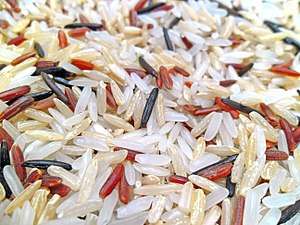Champa rice
Champa rice is a quick-maturing, drought resistant rice that can allow two harvests,[1] of sixty days each in one growing season. Champa rice originated from the aus subpopulation, which shares similarities with japonica and indica rice varieties of Eastern India, Myanmar, and Bangladesh.[2] Originally introduced into Champa from Vietnam, it was later sent to China as a tribute gift from the Champa state during the reign of Emperor Zhenzong of Song (r. 997–1022).[3][4] Consequently, Song officials gave Champa rice to peasants across China in order to boost yields, and its distribution was crucial in feeding the population of over 100 million in China.[5]
Commonly cultivated in India, Champa rice is consumed as main course in Southern parts of India.
See also
Notes

References
- ↑ Haywood, John; Jotischky, Andrew; McGlynn, Sean (1998). Historical Atlas of the Medieval World, AD 600-1492. Barnes & Noble. p. 3.21. ISBN 978-0-7607-1976-3.
- ↑ Barker, Randolph (2012). "The Origin and Spread of Early-Ripening Champa Rice: It's Impact on Song Dynasty China". RICE. 4: 184–186 – via SpringerLink.
- ↑ Lynda Noreen Shaffer, A Concrete Panoply of Intercultural Exchange: Asia in World History (1997) in Asia in Western and World History, edited by Ainslie T. Embree and Carol Gluck (Armonk, N.Y.: M.E. Sharpe), p. 839-840.
- ↑ Richard W. Bulliet; Pamela Kyle Crossley; Daniel R. Headrick; Steven Hirsch, Lyman Johnson (1 February 2008). The Earth and Its Peoples: A Global History, Brief Edition, Volume I: To 1550: A Global History. Cengage Learning. pp. 279–. ISBN 0-618-99238-3.
- ↑ Beck, Roger B.; Black, Linda; Krieger, Larry S.; Naylor, Phillip C.; Shabaka, Dahia Ibo (2012). World History: Patterns of Interaction. Houghton Mifflin Harcourt. p. 325. ISBN 978-0-547-49112-7.
